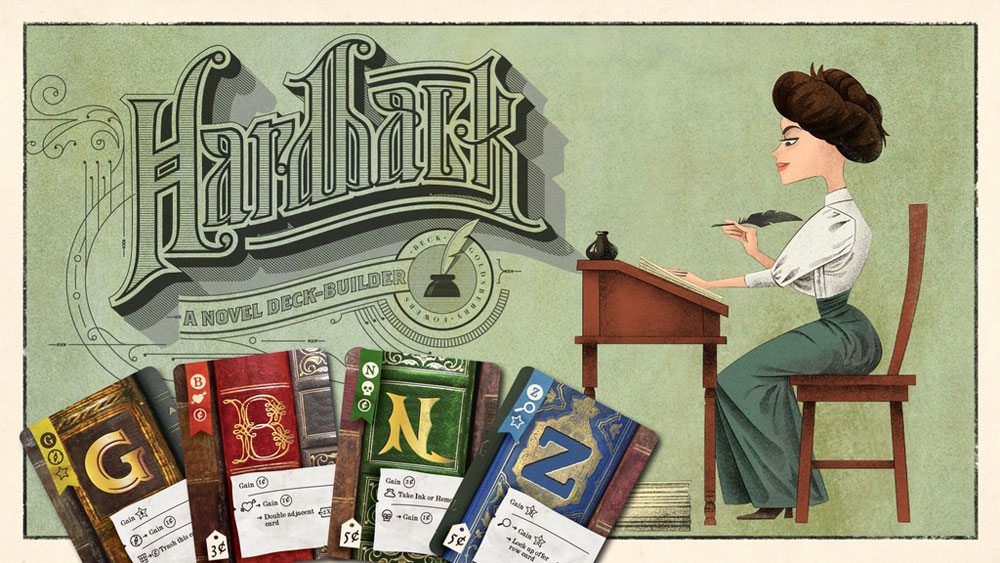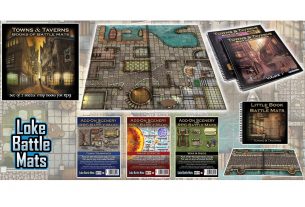Hardback is the “pre-quill” to Paperback, a word-making, deck-building game from Tim Fowers.
At a glance: Hardback is a deck-building word game for 2 to 4 players, ages 10 and up, and takes about 45 minutes to play. It’s currently seeking funding on Kickstarter, with a pledge level of $27 for a copy of the game. The game is a combination of deck-building and spelling, so any player with some degree of mastery of those two skills would be able to play.
New to Kickstarter? Check out our crowdfunding primer, and visit our Kickstarter curated page for more projects we love.

Components
- Scoreboard
- 40 Starting cards
- Letter cards
- 6 Bestseller cards
- Ink tokens (black cubes)
- Remover tokens (white cubes)
- 8 player markers (2 each in 4 colors)
Note: my review is based on a pre-production prototype, so components and final artwork are subject to change.
The game is mostly cards (as you’d expect from a deck-building game), and in this case each card is a letter of the alphabet. They’re made to look like letters printed on the spine of a book, with a scrap of paper showing the card’s effect. each card also has the letter in an index in the top left corner, made to look like a bookmark. Your starting cards are plain grey spines, but there are also four “genres” that have more colorful spines, along with icons representing the genres.
Based on Tim Fowers’ previous games, I expect that the look of the final components will change—the Bestseller cards are certainly placeholders, and the scoreboard is currently pretty plain-looking. The book spines will probably remain, but everything else (including the card backs) might be different by the time the game is released.
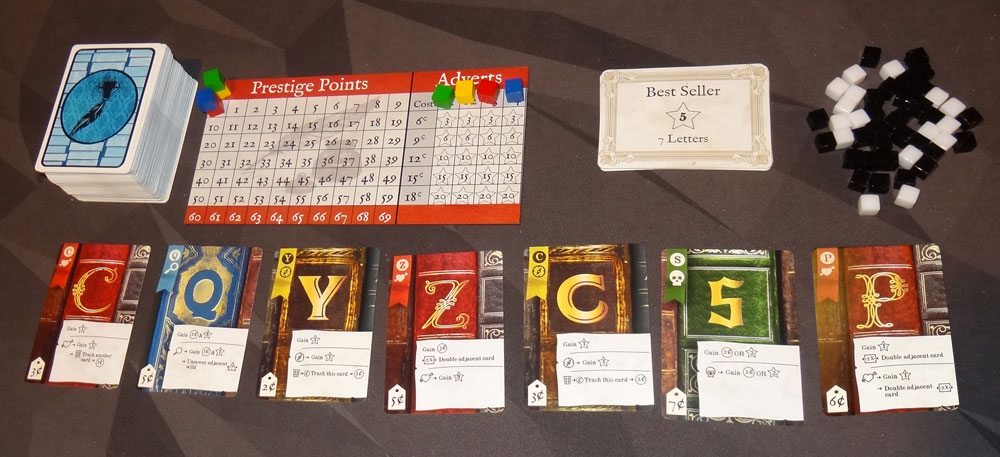
How to Play
You can read a draft of the rulebook here.
The goal of the game is to score the most points by the end of the game by making words (including the “Bestseller”) and buying advertisements.
Hardback is a deck-building game, which means that each player maintains their own deck and discard pile, adding cards to their own system as the game progresses.
To set up, you give each player a set of 8 starting 1¢ cards (A, E, I, L, N, R, S, T) and then two random starting Prestige cards. Each player shuffles their starting deck and draws 5 for their first hand. Each player puts one player marker on the “0” space of the score track, and one on the top of the advertisements tracker (on the respective player space).
Shuffle the deck of letter cards, and deal 7 face-up to form the “offer.” Stack the Bestseller cards in increasing order, and set those and the rest of the tokens nearby.
On your turn, you use the cards in your hand to spell a word. Any may be turned face-down to use it as a wild, but then you do not get the benefits of that card. If any of the cards in your word have stars in the benefits section, you earn that many points on the scoreboard immediately. If your cards earn you money, you may spend those to buy letters from the offer, ink tokens, and advertisements. You may make as many purchases as you can afford, and any cards you purchase go into your discard pile. Any time a card is removed from the offer, flip the next card from the letter deck to refill its space.

Ink tokens cost 1¢ apiece—I’ll explain what those do later. To buy an advertisement, pay the cost shown on the next level of advertisement (the first one costs 6¢), earn the points shown, and then move your player marker down one row. The next time you buy an advertisement, it will cost more money and be worth more points. [UPDATE: The adverts is actually a stretch goal currently, so it may not be included in the final game unless the campaign reaches a certain funding level.]
There are two important rules (that I kept forgetting) about the offer. Before you purchase any cards on your turn, if at least four cards in the offer cost 6¢ or more, or if there are at least four cards of the same genre in the offer, you may flush the offer (discard all of them) and refill the row once.
Finally, if you form a word with at least 7 letters, you may have a chance at a bestseller. Essentially when you make a long word, you get to take the Bestseller card for that word length. But no resting on your laurels: anyone who makes a word of that length gets to steal that card from you (hey, it’s the cult of the new). In addition, any of the Bestseller cards for shorter lengths are removed from the game. So to get the Bestseller, you must match or exceed the current record for word length. These points are only scored at the end of the game, so do not move your scoring marker at this time.
At the end of your turn, you discard all cards (whether you played them or not) and then draw back up to five cards. If you run out of cards to draw, reshuffle your discard pile to form a new deck.
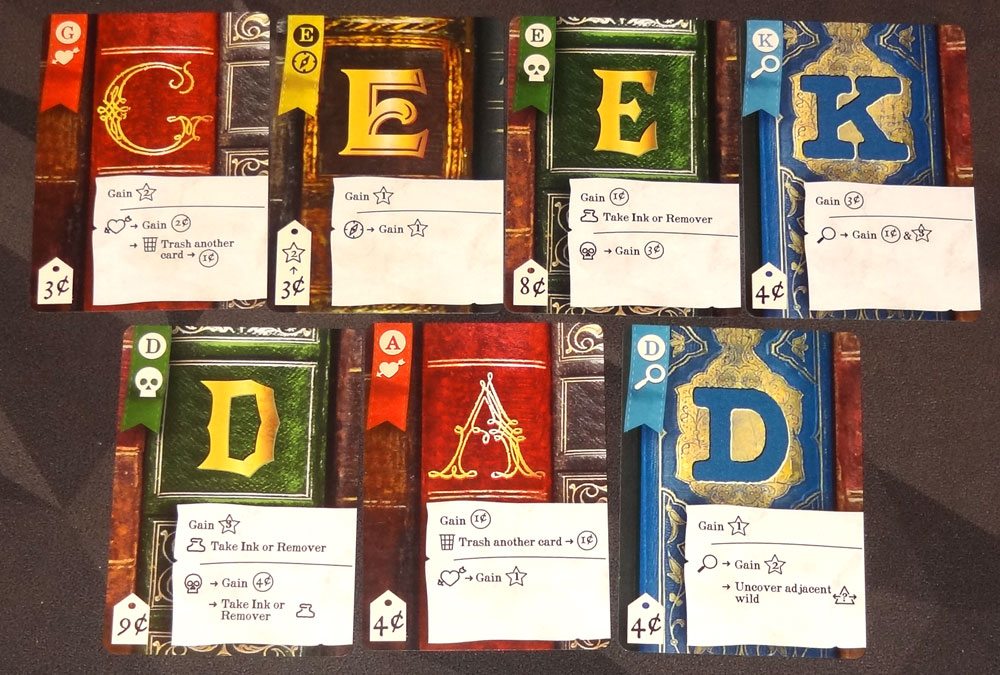
The non-starting letter cards come in four different genres; while all of the cards have some combination of money and points, each genre also has some abilities that are specific to it. Also, the genre cards have a basic benefit that triggers when used in a word, and then a genre bonus benefit that triggers only if you have at least one other letter of the same genre in your word.
- Adventure: Some Adventure cards award points immediately when purchased, and some give the ability to trash themselves (removing them from the game) in order to gain more money or prestige.
- Horror: Horror cards may allow you to take an ink or remover from the supply, and are the only way to obtain remover. Each remover token may be spent to remove an ink token from a card you’ve drawn, thus allowing you the option of leaving that letter out of your word. They also have some abilities that give you a choice between money and prestige.
- Mystery: Mystery cards can uncover adjacent wild cards, letting you use their benefits even though you used the card as a wild letter. Some Mystery cards can also let you remove a card from the offer, replacing it immediately.
- Romance: Romance cards may let you trash a card (an unused card in your hand or a card from your discard pile) for extra money. They can also double adjacent cards: pick either money or prestige earned from that card, and double it. (If multiple double effects are used on the same card, each effect adds 1x—you don’t double the double.)
Ink tokens have two uses: first, you can use 3 ink tokens for an extra cent when purchasing. Secondly, you can use them to press your luck and draw more cards. After you’ve drawn your five cards, you may use ink tokens to draw additional cards—one card per ink used. These cards are placed face-up on the table, with the ink tokens placed on them. Any card with an ink token must be used as that letter in your word and may not be flipped face-down as a wild. If you’re unable to make a word with all the letters you drew with ink tokens, then you’ll lose your turn and do nothing but discard everything and draw back up. Either way, ink tokens are discarded back to the supply after your turn is over.
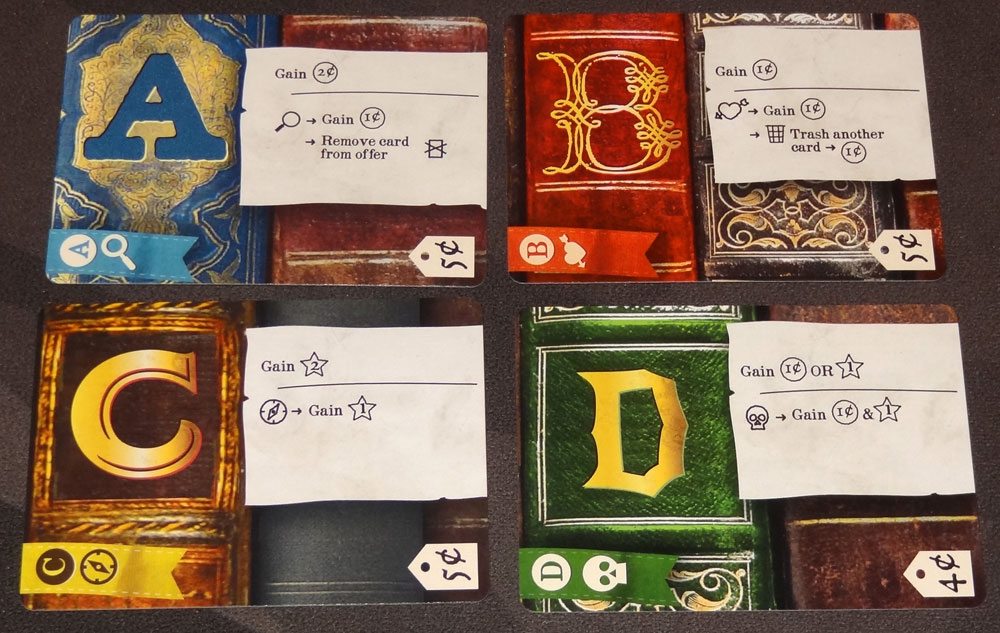
Finally, there are some “persistent” letters—they’re printed horizontally instead of vertically on the cards so they stand out more. If you acquire a persistent letter and use it in a word, it stays on the table in front of you, and while it’s there, you automatically get the benefits of that letter each turn as if you used it in a word. Other players may include your persistent letter in any word they make—they don’t get the benefits, but it does cause the persistent letter to be discarded so you have to play it again later.
If you get stuck and can’t spell a word with your cards, you can also offer a bounty for other players. Reveal your cards, and if anyone suggests a word that you end up using, they get to take one ink token from the supply. It’s a small benefit to them, but it may be worth a lot to you. You may wonder why an opponent would make a word for you when all they get is a single ink, but if you put a jumble of letters in front of a word game lover, I assure you that it’s very hard for them not to blurt out words that they can spell with them. (And once one person comes up with a word, everyone else tries to come up with a better word.)
The game end is triggered when any player reaches 60 points or more; the current round is finished so that everyone had the same number of turns. Then add in the Bestseller bonus, and the highest score wins.
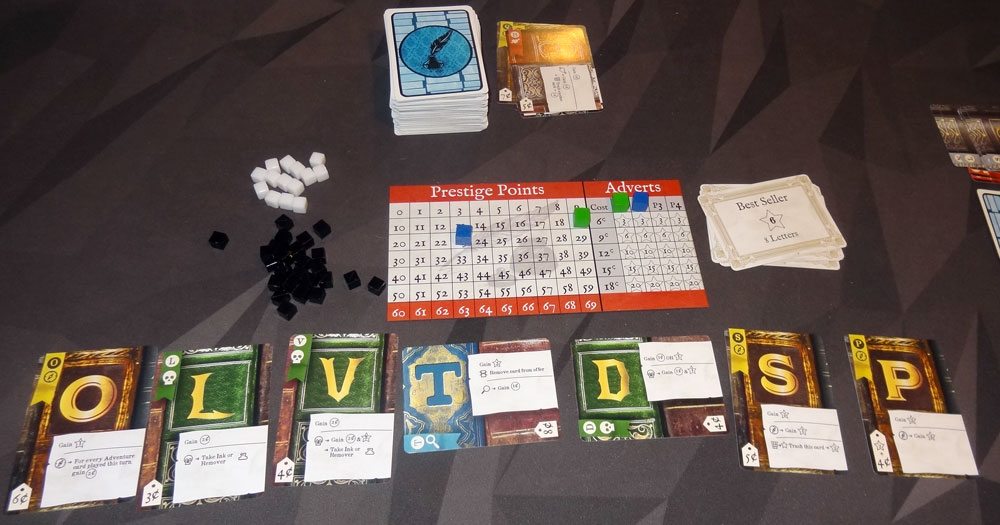
The Verdict
In my review of Paperback, I compared it to Scrabble-meets-Dominion: it’s a game about making words and building your deck, and a lot of the card effects would be very familiar to players of Dominion in terms of drawing more cards, making some cards more valuable, and so on. You build words to make money, spend money on cards, and your points are mostly based on cards that you purchase (which are primarily valuable as points but don’t really benefit you otherwise).
Hardback reminds me a bit more of Star Realms: playing multiple cards of the same genre gets you additional benefits, and the persistent cards remind me of the bases, which stay in play beyond a single turn. Also, the score is earned during the game, rather than just counting up points in your deck at the end of the game. There are only 7 cards in the offer, rather than a whole slew of them, so it’s a smaller market to buy from each time (making the “remove a card from offer” ability more important). That’s mostly where the resemblance ends, though, and Hardback has some really intriguing plot twists that I didn’t see coming.

Take, for instance, the ink tokens and the press-your-luck element. Buying ink and spending it as money isn’t entirely a new concept—there are other games in which you can pay now in order to have more money to spend on a future turn, though in this case it’s a single use. But using ink to draw more cards is extremely powerful. It’s a good way to get those matching genre cards into play in the same word, and it’s also the only way to write a bestseller. Unlike most deck-building games, in Hardback there are no card effects that let you draw cards, so the only way to get more than 5 cards in your hand is to use ink. (Technically you could create a word with more than 5 letters if there are a lot of persistent letters on the table, but that’s not something you can control yourself.) I like that letters drawn with ink must be used in your word, making it possible to “bust” and lose your turn. However, since any letter from your initial 5-card hand can be turned into a wild, busting isn’t too common (unless you’ve bought a pile of Qs). Chances are that you will be able to spell a word; it just might not be the word you want.
Appropriately, Hardback does seem a bit heavier than Paperback when it comes to the deck-building strategy. Choosing the genres you purchase is an important decision. Genre cards are better when you have more than one of them, so you typically want to focus on one or two genres so that you can draw them at the same time. But which ones? All of them can have powerful abilities. Getting remover tokens with Horror cards allows you to draw more cards without worrying about getting stuck using all of those letters if you don’t like what you get. Romance cards and Adventure cards both have ways of weeding out your deck. Mystery cards are handy for getting benefits from cards that you’ve flipped over to use as wilds. I like the mix of abilities and the way they’re split up by genre, because it means that you start to develop a focus as you add cards to your deck.
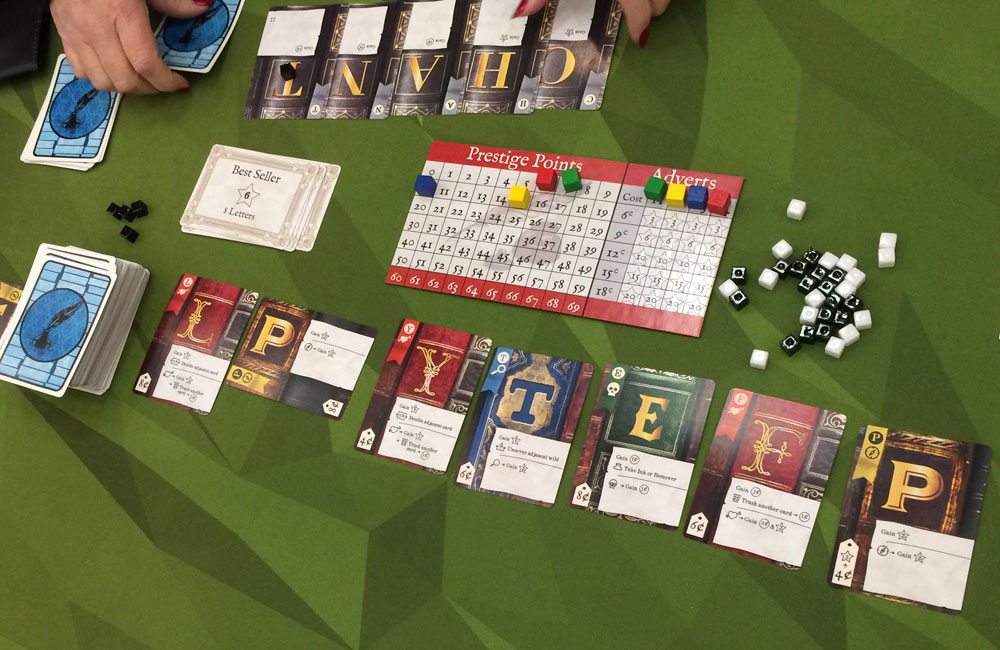
I have to admit that, so far, I’m not very good at Hardback. I buy cards and then find myself unable to use them in words, or I get too many genres and never draw sets of them together, or I just don’t have enough cards that earn money so I can buy more cards. I’m probably too timid about pressing my luck with ink tokens, and I forget to buy advertisements until it’s really late in the game. But even with all of that, I’m really enjoying it. It’s different enough from Paperback that it doesn’t feel like a retread even though both of them involve making words.
If you’re a fan of Paperback already, I’m guessing you may have already clicked through to back the project about 2,000 words ago. If you haven’t played Paperback, I would say it depends on your comfort level with deck-building games. Paperback will be easier for less-experienced players who love word games to jump in, but Hardback puts more weight on the deck-building side and is perhaps a little less focused on the word-making itself—though of course you can get some pretty big bonus points for making extra-long words.
For more information about the project or to make your pledge, visit the Hardback Kickstarter page now!
